Do you know how to take care of a bonsai? The care and maintenance of bonsai trees are pretty complex and require more attention than your average houseplant. But, once you go through the basic principles of bonsai care, you can grow and maintain any bonsai.
You can make bonsai of any tree or plant, knowing the proper care and styling techniques. Bonsais are the recreations of their parent trees. So, they need ideal conditions similar to the parent tree, like light, humidity and soil nutrition.
Proper pruning is also necessary to keep them in the desired shape and to trigger the flowering and fruiting at the right time. So, by keeping these basic things in mind, taking care of a bonsai tree isn’t as challenging as it seems.
This post explains what actually a bonsai is and provides guidelines for beginners on how they should take care of bonsai.
Content: How to Take Care of a Bonsai?
What is Bonsai?
Bonsai trees or plants should not be misinterpreted as dwarves. Instead, they are miniature of their parent tree grown in small containers. Bonsais are pruned and maintained in a way that they look like a much smaller version of their full size.
The cultivation of bonsai is a Japanese art form. But, this art form was derived from ancient Chinese farming practices. So, we can say that growing bonsais is a fusion of horticultural expertise and art.
Growing bonsais aims to make a miniaturized but realistic representation of a parent tree. One can represent the beauty of nature in a small space by producing such miniatures.
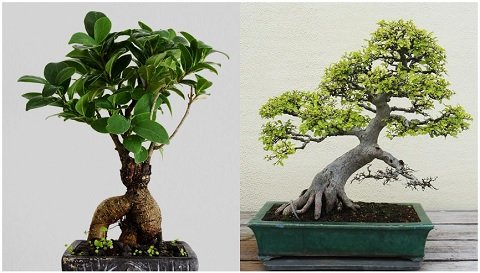
Bonsai trees can live longer than full-sized trees. Due to their small size, it becomes easy to give attention to the things necessary for their growth and survival:
- Health, water and nutritional needs.
- Protection from weather extremes.
- Mechanical injuries.
- Protection from pests and insects.
Bonsais can be kept in homes, backyards, offices and many other places. Their appearance gazes all the attention and certainly adds aesthetic value to your home.
Bonsai Tree Care
This post is for beginners that digs into the points necessary for taking care of bonsais like placement, watering, soil, fertilizing, pruning and repotting.
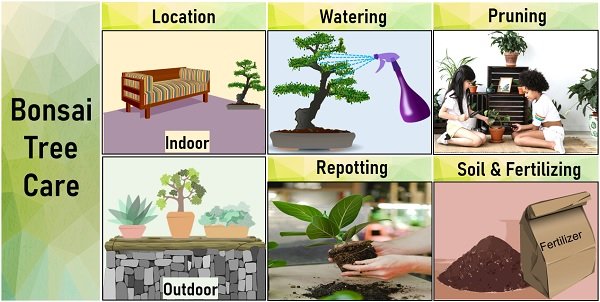
Placement of Bonsai
The location where you keep your bonsais is crucial for their health. To be scientifically correct, bonsai is not a plant but a tree. To grow a healthy tree, you’ll need to place it in the right place under the right conditions. To do so, you must choose a perfect location for a bonsai considering the type of plant and climatic conditions.
The bonsai adds aesthetic value and a peaceful feel to your room or outer space. To determine the best location, you must know what type of tree it is (indoor or outdoor).
Juniper, pine and spruce trees are outdoor plants. Deciduous trees (like maple, elms and ginkgo) are the common outdoor bonsai trees. Indoor bonsai trees include subtropical species (jade plants, Hawaiian umbrella trees, and ficus trees).
Once you know the type of bonsai tree you have, the rest is pretty simple. Knowing that every plant needs sunlight, you should understand the indoor and outdoor growing conditions. A lack of sunlight can damage them, causing weak foliage and other problems.
- Indoor plants do not need much sunlight so they can be kept near the windows or under artificial lighting.
- However, outdoor plants need adequate sunlight to remain healthy. So, balconies, backyards or rooftops would be a great place to keep your outdoor bonsais.
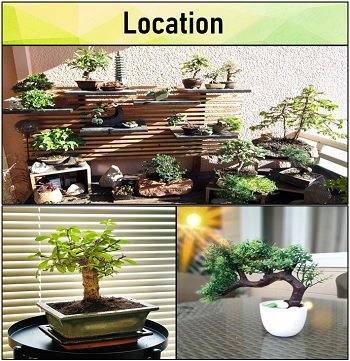
Important Guidelines
- The temperature should be under 40 degrees Celsius for the bonsai kept outdoors. More sunlight and warmth will cause drying of soil and the bonsai tree too.
- The early morning is an excellent time to feed some sunlight than the scorching afternoon.
- Bonsais need sunlight for at least 5-6 hours daily to make their food.
- Keep your bonsai far off from direct heat.
- Bonsais need moisture in the soil.
Soil for Your Bonsai
Bonsai require a small amount of soil due to the small container size. You are wrong if you think that any ordinary soil will do for your bonsai. The ideal soil for bonsais must remove excess water, permit oxygen, and retain water and nutrients.
You must pick sandy soil that offers proper drainage, or you can buy soils made just for bonsais. So, it’s your choice whether you purchase or mix your soil, but the soil must contain the following ingredients:
- Compost supplies necessary nutrients and supports water retention.
- Red lava rock chips allow nutrients to seep through, restrict fertilizer buildup and keep the soil from compacting.
- Pumice stones aid in aeration, hold moisture and support the roots.
- Akadama is a granular clay that improves the water-holding capacity in the soil mixture and supports root absorption.
Fertilizing a Bonsai
Tree depletes soil nutrients as they grow. Fertilizer is more like vitamins and minerals. So, by adding the right fertilizer or compost, we can nurture the soil with the necessary nutrients.
Liquid fertilizer is fast-acting, while solid fertilizer slowly diffuses into the soil. So, you can choose any liquid fertilizer from the nearby nurseries.
Adding fertilizer to the soil during the growing season of bonsais is also crucial. The ideal fertilizer should have a balanced amount of nitrogen, phosphorus and potassium. It’s best to use mild or urea-free fertilizer every time you water.
Important Guidelines
- For effective growth of bonsai, you can use fertilizer once a month.
- You should not add fertilizer to weak or freshly repotted trees.
- Fertilization during the growing season of bonsais is essential for them to thrive.
- Bonsai quickly access the soil nutrients due to the small pot size. So, they need proper fertilization to replenish the soil’s nutritional content.
- Direct application of fertilizers to dry soil harms the plant or tree. So, it would be best to water your bonsais before adding fertilizer.
- Always follow the directions on the fertilizer container to avoid over-fertilizing. The overuse of fertilizers may burn the roots and cause stress to the tree.
Watering
It is the most important factor in taking care of your bonsai trees. Water your bonsai! You may think that it’s not necessary. But like every plant or tree, bonsai also need water when the topsoil appears dry.
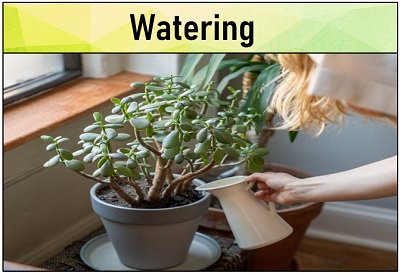
The watering frequency may differ depending on the type of bonsai, the soil you use, and the weather cycle.
- During winters, you may be watering once a week or even less.
- But, you may water very frequently during summers or on alternate days.
Thus, it is best to water your bonsai when needed rather than watering on a set schedule.
Important Guidelines
- You can water the bonsai tree once a week. But, you must constantly check the topsoil from June-July-August, when the temperature is sky high.
- Before watering, you should watch your bonsai trees daily. It’s best to add water as you see the dryness in the top layer of the soil.
- To ensure complete soil saturation with water, you must continue watering until the water escapes from the draining holes.
- Overwatering and underwatering can be detrimental to your bonsai tree. It causes yellowing of leaves, shrivelling of smaller branches, drowning of roots etc.
Methods of Watering
Watering must be done by monitoring the moisture in the soil using the following methods:
- Finger method: Insert your finger two inches into the soil to check whether the potting mix feels bone-dry. If it’s dry, then immediately add water.
- Chopstick method: In this, insert a chopstick in the middle and up to one inch into the soil. After 10 minutes, remove the chopstick. If you see soil particles around the chopstick, there’s sufficient moisture in the soil. If not? Then it’s bath time!
- Soil moisture meter: Here, you need to place the meter inside the soil, near the root mass. Then, the scale will display readings, indicating whether your bonsai needs water or not.
Pruning of Bonsai
Pruning a bonsai is an art form which requires lots of effort and creative skills. Pruning aims to keep bonsais small and maintain their proper shape.
You can give any shape to your bonsai by trimming. If you are a beginner, you can take the help of professionals or refer to some tutorials to give a distinct shape to your bonsai.
The right time for pruning is when you see any growth that morphs into the desired shape of your tree. It is an exciting activity that calms you down and gives you a feel of relaxation by simply trimming this miniature tree.

Methods of Pruning
Below, we will discuss different methods to shape your bonsai.
Maintenance Pruning
It maintains and refines the bonsai shape. To do so, you need to cut the outgrown branches from the canopy of a tree using twig shears or regular cutters. Tropical and Subtropical trees need more periodic pruning than others.
Generally, branches, buds and leaves require maintenance pruning.
- Cutting off branches ensures the growth of smaller branches and controls the overall shape of your bonsai. Instead of using scissors, use bonsai clippers to remove any dead branches.
- Pruning of buds results in the growth of more compact or smaller leaves.
For outdoor bonsais, you can perform maintenance pruning from march to september. In contrast, indoor bonsais can be pruned year-round. Pruning of flowering bonsais can be done during the spring to promote flowering right all year round.
Structural Pruning
It is done when the tree is dormant. The best time for structural pruning is just before and after the growing season of bonsai (early spring and late autumn).
However, the time may differ depending upon species variability. To do structural pruning, you need to examine your bonsai closely. First, remove all the dead branches from the tree.
Clean up the top growth to keep the bonsai small. Once that’s done, choose the branches to trim to give the desired shape to your bonsai. Designing your bonsai is a creative process and not something bound by rules.
Trim and Wiring
You can shape your bonsai and control the growth pattern by wrapping a thin wire around the branches. The best time for wiring is during winter when the bonsai leaves shed off.
You have to keep an eye on the branch’s growth. Remove the wire if a branch grows too fast into the wire, as this develops scars on the branches.
Repotting of Bonsai
This step involves chopping off excess roots that may starve the bonsai tree. Professionals believe that for the maintenance of bonsai, repotting of a bonsai must be done once, every 2-5 years.
Repotting ensures the survival of bonsai within a small pot. It is done because as the roots grow and multiply, there is a possibility that nutrients may not reach each root.
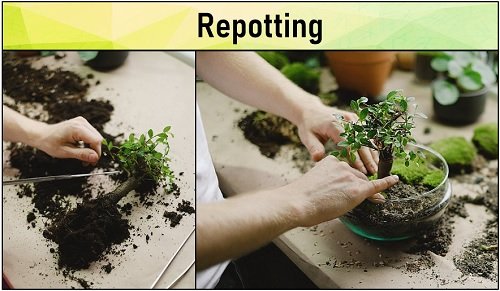
So, doing this step, you change the soil and pot and ensures every possible thing to freshen up the tree.
Important Guidelines
- Carefully remove the bonsai from the pot.
- Cut down the root outer layers using sharp bonsai clippers.
- If you inspect any rot in the root mass, immediately trim away that portion.
- You can bring a new pot, or you may clean the pot thoroughly by removing fungal or algal biomass.
- Then place mesh squares to avoid soil from falling out.
- Layer your soil with required particles or pebbles and clay.
- At last, place the tree on it.
Due to the small size of the pot, the roots of bonsai have a limited space to grow. Thus, repotting becomes necessary to cut the extended roots from the soil.
Periodic repotting avoids root binding, replenishes soil nutrients, and forms vigorous roots. The perfect timing for repotting is when the roots come out through the drainage holes or crawl over the soil.
You should avoid repotting in winter because, at that time, the tree, in its dormant phase, stores enormous energy in its root.
Conclusion
Following the tips or guidelines discussed in this post, you can keep your bonsai tree healthy for years and years.
